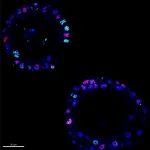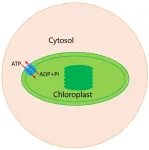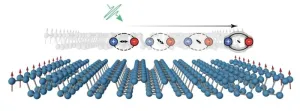(Press-News.org) Until now, doctors knew hepatic stellate cells mainly as drivers of liver fibrosis. The actual functions of this cell type have hardly been studied to date. Researchers from the German Cancer Research Center (DKFZ), the Mannheim Medical Faculty and Columbia University in New York have now published in the journal Nature that hepatic stellate cells control liver metabolism as well as liver regeneration and size. The results of the study could contribute to new therapeutic approaches for liver diseases.
The liver is a central organ for carbohydrate and protein metabolism as well as for the detoxification of endogenous and exogenous substances. Its vital functions require a high regenerative capacity. Liver cells, so-called hepatocytes, make up about 60 percent of the total cell number of the organ. They have important metabolic tasks and are active in detoxification and metabolism. Endothelial cells provide mass transfer, cholangiocytes transport bile, and Kupffer cells act as a protective barrier.
Hepatic stellate cells are located along the specialized blood capillaries of the liver, known as sinusoids. They are known to drive liver fibrosis, but their actual physiological functions and interactions with other cells are largely uninvestigated.
Scientists led by Hellmut Augustin, DKFZ and the Mannheim Medical Faculty of Heidelberg University, and Robert F. Schwabe, Columbia University, New York, have now shown that stellate cells are essential for liver regeneration and liver metabolism.
Using a genetic trick, the teams led by the two senior authors bred mice whose livers contained no stellate cells. This affected the organ's detoxification function and its ability to regenerate after injury. The finely balanced architecture of the liver lobules, in which the hepatocytes are arranged according to their different metabolic tasks, was completely disrupted without stellate cells.
The protein Rspondin 3 (RSPO3), which is preferentially produced in stellate cells and regulates the important WNT signaling pathway in liver cells, proved to be a key player in this process. When the researchers specifically switched off RSPO3 in stellate cells, this genetic manipulation had the same effects as the loss of stellate cells.
“The results show that hepatic stellate cells are not only involved in pathological processes, but also play an active role in protecting and regulating liver function,” explains Hellmut Augustin. ”It is particularly noteworthy that the selective silencing of Rspondin 3 leads to similar effects as the removal of the stellate cells themselves – with serious consequences for liver health.”
The researchers also showed that low RSPO3 levels are associated with unfavorable disease progression in patients with alcohol-associated and metabolic liver disease. The new results provide a potential approach for future therapeutic strategies. Instead of focusing solely on inhibiting stellate cells to prevent the development of fibrosis, future treatments could specifically maintain and support their positive, protective functions.
Publication:
Atsushi Sugimoto, Yoshinobu Saito, Guanxiong Wang, Qiuyan Sun,,Chuan Yin, Ki Hong Lee, Yana Geng, Presha Rajbhandari, Celine Hernandez, Marcella Steffani, Jingran Qie, Thomas Savage, Dhruv M. Goyal, Kevin C. Ray, Taruna V. Neelakantan, Deqi Yin, Johannes Melms, Brandon M. Lehrich, Tyler M. Yasaka, Silvia Liu, Michael Oertel, Tian Lan, Adrien Guillot, Moritz Peiseler, Aveline Filliol, Hiroaki Kanzaki, Naoto Fujiwara, Samhita Ravi, Benjamin Izar, Mario Brosch, Jochen Hampe, Helen Remotti, Josepmaria Argemi, Zhaoli Sun, Timothy J. Kendall Yujin Hoshida, Frank Tacke, Jonathan A. Fallowfield, Storm K. Blockley-Powell,Rebecca A. Haeusler, Jonathan B. Steinman, Utpal B. Pajvani, Satdarshan P. Monga,Ramon Bataller, Mojgan Masoodi, Nicholas Arpaia, Youngmin A. Lee, Brent R. Stockwell, Hellmut G. Augustin & Robert F. Schwabe: Hepatic stellate cells control liver zonation, size and functions via Rspondin 3.
Nature 2025, DOI: https://www.nature.com/articles/s41586-025-08677-w
A picture is available for download:
https://www.dkfz.de/fileadmin/user_upload/Skoe/Pressemitteilungen/2025/PM_Augustin_Nature.jpg
Caption: Hepatic stellate cells control the function of the liver. The different colors show specialized functions of the liver cells within the pentagonal to octagonal liver lobules.
Note on use of images related to press releases
Use is free of charge. The German Cancer Research Center (Deutsches Krebsforschungszentrum, DKFZ) permits one-time use in the context of reporting about the topic covered in the press release. Images have to be cited as follows: “Augustin / DKFZ”.
Distribution of images to third parties is not permitted unless prior consent has been obtained from DKFZ’s Press Office (phone: ++49-(0)6221 42 2854, E-mail: presse@dkfz.de). Any commercial use is prohibited.
END
Hepatic stellate cells control liver function and regeneration
2025-03-12
ELSE PRESS RELEASES FROM THIS DATE:
The secret DNA circles fueling pancreatic cancer’s aggression
2025-03-12
Pancreatic cancer is one of the deadliest cancers worldwide, with a five-year survival rate of 13%. This poor prognosis stems from both late detection and the cancer’s notorious capacity to adapt and resist therapy. Now, a study led by researchers at the University of Verona, University of Glasgow, and the Botton-Champalimaud Pancreatic Cancer Centre uncovers a hidden driver of this adaptability: extrachromosomal DNA (ecDNA).
A New Player in Pancreatic Cancer
The team found that some pancreatic cancer cells gain a major survival edge by carrying copies of critical cancer genes—such as ...
2D metals: Chinese scientists achieve breakthrough in atomic manufacturing
2025-03-12
Since the groundbreaking discovery of graphene in 2004, the dizzying pace of progress in two-dimensional (2D) materials has ushered in a new era of fundamental research and technological innovation. Although nearly 2,000 2D materials have been theoretically predicted and hundreds have been created in laboratory settings, most of these 2D materials are limited to van der Waals (vdW) layered crystals.
Scientists have long been keen to develop atomically thin 2D metals, thereby expanding ...
Cause of post-COVID inflammatory shock in children identified
2025-03-12
MIS-C is a serious inflammatory shock that affects children. It can occur several weeks after a COVID infection and can be life-threatening. Until now, however, the precise cause of the condition was unknown. Researchers at Charité – Universitätsmedizin Berlin and the German Rheumatology Research Center (DRFZ), an institute of the Leibniz Association, have identified that reactivation of a pre-existing, dormant infection with the Epstein-Barr virus triggers an excessive inflammatory response. The researchers have detailed their findings in an article in Nature.* These insights open the door to new treatment methods, potentially not limited to MIS-C.
The majority of children ...
QIA researchers create first Operating System for Quantum Networks
2025-03-12
Delft, The Netherlands: Quantum Internet Alliance (QIA) researchers at TU Delft, QuTech, University of Innsbruck, INRIA and CNRS recently announced the creation of the first operating system designed for quantum networks: QNodeOS. The research, published in Nature, marks a major step forward in transforming quantum networking from a theoretical concept to a practical technology that could revolutionize the future of the internet.
“The goal of our research is to bring quantum network technology to all. With QNodeOS we're taking a big step forward. We're making it possible – ...
How the brain uses ‘building blocks’ to navigate social interactions
2025-03-12
Our brains use basic ‘building blocks’ of information to keep track of how people interact, enabling us to navigate complex social interactions, finds a new study led by University College London (UCL) researchers.
For the study, published in Nature, the researchers scanned the brains of participants who were playing a simple game involving a teammate and two opponents, to see how their brains were able to keep track of information about the group of players.
The scientists found that rather ...
Want to preserve biodiversity? Go big, U-M researchers say
2025-03-12
ANN ARBOR—Large, undisturbed forests are better for harboring biodiversity than fragmented landscapes, according to University of Michigan research.
Ecologists agree that habitat loss and the fragmentation of forests reduces biodiversity in the remaining fragments. But ecologists don't agree whether it's better to focus on preserving many smaller, fragmented tracts of land or larger, continuous landscapes. The study, published in Nature and led by U-M ecologist Thiago Gonçalves-Souza, comes to a conclusion on the decades-long debate.
"Fragmentation is bad," said study author Nate Sanders, U-M professor of ecology and evolutionary biology. ...
Ultra-broadband photonic chip boosts optical signals
2025-03-12
Modern communication networks rely on optical signals to transfer vast amounts of data. But just like a weak radio signal, these optical signals need to be amplified to travel long distances without losing information. The most common amplifiers, erbium-doped fiber amplifiers (EDFAs), have served this purpose for decades, enabling longer transmission distances without the need for frequent signal regeneration. However, they operate within a limited spectral bandwidth, restricting the expansion of optical networks.
To meet the growing demand for high-speed data transmission, researchers have been seeking ways to develop more powerful, flexible, ...
Chinese scientists explain energy transfer mechanism in chloroplasts and its evolution
2025-03-12
A recent study by Chinese scientists has revealed the intricate molecular machinery driving energy exchange within chloroplasts, shedding light on a key event in the evolution of plant life. Led by FAN Minrui from the Center for Excellence in Molecular Plant Sciences of the Chinese Academy of Sciences, the research elucidates the structure and function of the ATP/ADP translocator—a crucial member of the nucleotide transporter (NTT) family of proteins—which facilitates the transfer of energy across chloroplast membranes.
Their findings were published online in ...
Exciting moments on the edge
2025-03-12
Scientists have long suspected that phosphorene nanoribbons (PNRs) – thin pieces of black phosphorus, only a few nanometres wide – might exhibit unique magnetic and semiconducting properties, but proving this has been difficult. In a recent study published in Nature, researchers focused on exploring the potential for magnetic and semiconducting characteristics of these nanoribbons. Using techniques such as ultrafast magneto-optical spectroscopy and electron paramagnetic resonance they were able to demonstrate the magnetic behaviour of PNRs at room temperature, and show how these magnetic properties can interact with light.
The ...
MD Anderson Research Highlights for March 12, 2025
2025-03-12
HOUSTON ― The University of Texas MD Anderson Cancer Center’s Research Highlights showcases the latest breakthroughs in cancer care, research and prevention. These advances are made possible through seamless collaboration between MD Anderson’s world-leading clinicians and scientists, bringing discoveries from the lab to the clinic and back.
Study offers insights into evolutionary process driving pancreatic cancer
Read summary | Read study in Nature
Pancreatic cancer is hard to treat because ...





